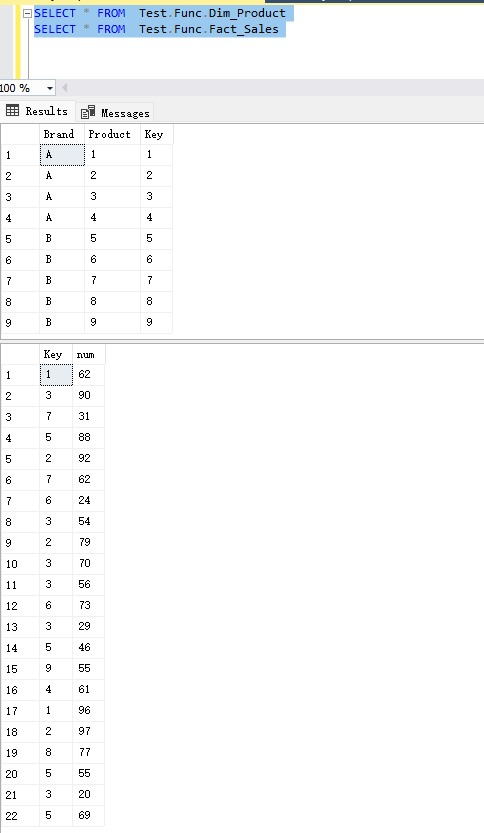WIINDOW函数
一、 语法
WINDOW ( <From> [, <FromType>], <To> [, <ToType>] [, <Relation>] [, <OrderBy>] [, <Blanks>] [, <PartitionBy>] [, <MatchBy>] [, <Reset>] )
Window ( <起始位置>,<起始位置类型>,<结束位置>,<结束位置类型>, [<关系>], [<OrderBy>],[空白],[PartitionBy] )

备注:
OrderBy、PartitionBy中出现的列,需要先在“关系表”中引用。
二、数据准备
2.1 SQL中的数据

2.2 PB中的数据
Dim_Product

Fact_Sales

Relationship

三、 代码
3.1 SQL 代码
SELECT Brand,Product,[num] ,SUM([num]) OVER (ORDER BY num ) as sum_window ,SUM([num]) OVER () as sum_total ,SUM([num]) OVER (PARTITION BY Brand ORDER BY num ) as sum_window_partition ,SUM([num]) OVER (PARTITION BY Brand ) as sum_total_partition FROM ( SELECT B.Brand,B.Product,SUM([num]) AS num FROM Test.Func.Fact_Sales AS A LEFT JOIN Test.Func.Dim_Product AS B ON A.[Key] = B.[Key] GROUP BY B.Brand,B.Product ) t1 order by Brand,num

3.2 POWER BI 代码
EVALUATE VAR t1 = SUMMARIZE ( Fact_Sales, Dim_Product[Brand], Dim_Product[Product], "@num", SUM ( Fact_Sales[num] ) ) VAR t2 = ADDCOLUMNS ( t1, "sum_window", SUMX ( WINDOW ( 1, ABS, 0, REL, t1 , ORDERBY( [@num] ), ), [@num] ), "sum_total", SUMX ( WINDOW ( 1, ABS, -1, ABS, t1 , ORDERBY([@num] )), [@num] ), "sum_window_partition", SUMX ( WINDOW ( 1, ABS, 0, REL, t1, ORDERBY([@num] ),,PARTITIONBY(Dim_Product[Brand]) ), [@num] ), "sum_total_partition ", SUMX ( WINDOW ( 1, ABS, -1, ABS, t1, ORDERBY([@num] ),,PARTITIONBY(Dim_Product[Brand]) ), [@num] ) ) RETURN t2 ORDER BY Dim_Product[Brand],[@num]




 浙公网安备 33010602011771号
浙公网安备 33010602011771号